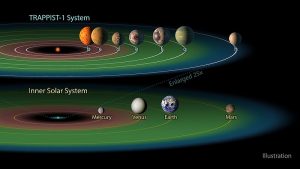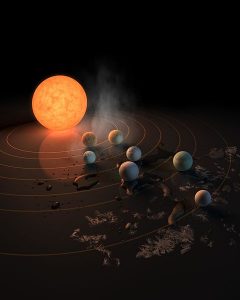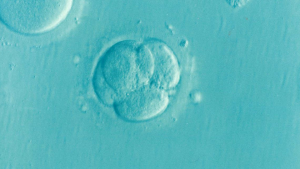Recently, NASA announced in a press-release conference confirming that there are seven Earth-sized planets which could potentially support life. This discovery gives hope for future colonization and the possibility for intelligent life forms, or aliens!
“This gives us a hint that finding a second Earth is not a matter of ‘if’, but ‘when’.” – Thomas Zurbuchen, associate administrator of NASA’s Science Mission Directorate
Although many other planets are said to be habitable as well, such as Kepler-186f, this is the first time scientists found so many Earth-sized planets, ranging from 25% smaller to 10% bigger than Earth, revolving around the same star. This gives us an increased chance of finding a “Second Earth”.

This image shows the similarities between the TRAPPIST system and our solar system (green regions represents habitable zones)
Source: Wikimedia Commons
Very much like our solar system, these planets orbit around a star called TRAPPIST-1, which resembles our sun but is younger, smaller, and less bright. The TRAPPIST system is around 378 trillion kilometers away from us. It would only take us 40 years to get there if we can travel at the speed of light!
Scientists are still looking for more evidence to determine if it is possible for us to live on those planets. Currently, NASA is using the Hubble Space Telescope to scout for the presence of atmosphere and signs of life, such as oxygen.
“There are many more life-supporting planets out there waiting for us to be discovered.” – Royal Sir Martin Rees, Astronomer
Furthermore, this discovery gave promising hope in finding life forms in three of the seven Earth-sized planets. These planets meet some of the basic requirements to support life: a solid planet that orbits around a star that serves as an energy source and the right distance away from the sun so liquid water can run on land. The possibility of aliens existing isn’t zero after all!
(Source: NASA Jet Propulsion Laboratory)
Imagine if all the resources on Earth had been used up and no longer habitable, where will we go? Now we have a target destination, we just need to figure out how to get there.
Although we are still a long way from colonizing a planet, we are certainly on the right track. We are also one step closer to answering the ultimate question that we all wonder, “Are we alone in the universe?”
By: Kevin Chao



